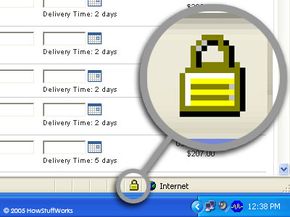The main drawbacks to electronic payments are concerns over privacy and the possibility of identity theft. Fortunately, there are many safeguards available to protect your sensitive personal information from falling into the wrong hands.
You can defend yourself against identity theft by using virus protection software and a firewall on your computer. You should also make sure that you send your credit card information over a secure server. Your Internet browser will notify you when a server is secure by showing a lock or key icon. In addition, the URL on a secure site is usually designated by the prefix "https" instead of "http." Retailers do their part by using data encryption, which codes your information in such a way that only the key holder can decode it.
Privacy concerns aside, some people simply dislike making electronic payments. They find the setup too time-consuming and don't want more logons and passwords to remember. Others simply prefer the familiarity of writing checks and dropping envelopes in the mail. Regardless of these concerns, electronic payment will likely continue to rise in popularity.
Next we'll learn how to set up e-payment for your small business.
FAQs
Electronic payment systems work by facilitating the exchange of funds between parties electronically. When a payment is initiated, the system securely processes the transaction details via a payment gateway that verifies the payer's identity and validates the transaction.
How does the electronic bill payment system work? ›
Electronic bill payment and presentment (EBPP) is a process that companies use to collect payments electronically through systems like the Internet, direct-dial access, and Automated Teller Machines (ATMs). It has become a core component of online banking at many financial institutions today.
How does electronic money work? ›
Electronic money (e-money) is a digital store of a medium of exchange on a computerized device. E-money can be used for payment transactions, with or without bank accounts. The great advantage of course is a cashless payment system that makes money transfers of any size quick and easy.
How does digital payment work? ›
The consumer starts payment transactions using UPI, mobile wallets or a similar option of his choice. The payment details are transmitted securely into the payment network. The payment network checks for the balance, thereafter, funds are moved from the consumer's bank account to the payee's bank account.
How safe is electronic payment? ›
Are digital payments more secure than offline payments? Digital payments are typically more secure than offline payments for a variety of practical reasons. First, paying for items using physical cash or cards requires that customers carry those items around with them, possibly exposing themselves to robbery.
How does a payment system work? ›
The customer provides their payment details—like card number or bank account information—at the business's POS, card reader, or ecommerce checkout. The payment information is securely transmitted to a payment gateway, which encrypts the data and forwards it to the payment processor.
How do electronic funds work? ›
The sender initiates the transfer over the internet or at a payment terminal. The transfer request is sent to the sender's bank and then back to the receiver's bank. EFTs are commonly used by businesses to pay employees, by utility companies to collect payment for services, and by retailers to pay suppliers.
How do banks keep track of electronic money? ›
Digital currency may be recorded on a distributed database on the internet, a centralized electronic computer database owned by a company or bank, within digital files or even on a stored-value card.
What are the disadvantages of electronic money? ›
The disadvantages of online payments include fraud risks, difficulty in tracing, technical issues, reliance on the internet, loss of smart cards, identity theft, and more.
How do you pay digitally? ›
This commonly includes several types of digital payments:
- Online electronic payment systems: Electronic bank transfers, eChecks, and wire transfers.
- Mobile payment apps: PayPal, Venmo, Zelle, etc. ...
- Digital cards: A credit, debit or prepaid card issued directly from a financial institution to a customer's mobile/e-wallet.
Electronic payments transfer financial values by means of online transactions on the Internet. They are understood to be any type of payment that is not made in cash. Digital payments are a type of electronic payment in which the transaction occurs online. However, they do not use any type of physical element.
How does digital account work? ›
Digital account opening is the method of opening a bank account or financial product completely online, eliminating the need for physical paperwork or in-person visits. It allows customers to easily initiate and complete the account opening process remotely, typically through a website or mobile app.
What are the risks of e-payments? ›
E-payments are convenient, fast, and secure, but they also come with various risks, such as fraud, cyberattacks, compliance issues, and operational failures. To protect your business and your customers, you need to design and implement an effective e-payment risk management framework.
What are the disadvantages of an electronic payment system? ›
10 Disadvantages and Concerns of Online Payments
- Risk of Fraud. This is the first concern that comes to mind when we think of risks related to digital payments. ...
- Technical Issues. ...
- Transaction Limits. ...
- Dependency on Internet. ...
- Identity Theft. ...
- Loss Of Cards. ...
- Unfamiliarity With Technology. ...
- Password Threats.
Login into bank website using the net banking user id and password. Select the payment details and make the payment. On successful transaction e-challan will be generated.
How do I pay someone electronically? ›
Key Takeaways:
- Venmo, Cash App, Google Pay, Zelle, PayPal, and wire transfer are some of the safest way to send money digitally.
- Money transfer apps are inexpensive and convenient options for paying family and friends.
- Wire transfers at a bank are ideal for securely sending large amounts domestically or internationally.
